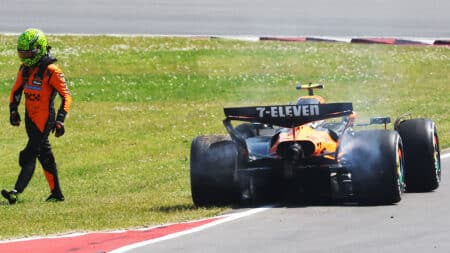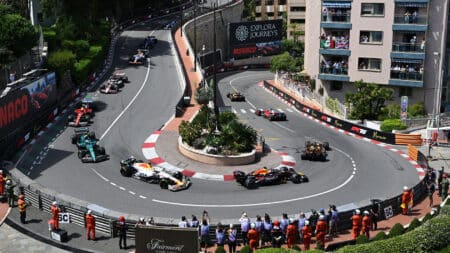
2025 is F1’s most polite title battle ever – Up/Down in Austria
Describing this year's championship race as a 'battle' might be slightly over-egging it, writes James Elson
There’s something very strange about being asked to ‘bring warm coats and woolly hats’ to an event near Birmingham in July. OK, the British summer hasn’t been great so far – and some tabloids are warning that we are about to enter a monsoon season – but there’s usually no need to be adorned in thermals.
Even when we knew we were off to the SnowDome in Tamworth and that the temperature inside was minus seven degrees it’s still very hard to imagine as you leave a damp, muggy London. The SnowDome is one of the only privately owned indoor slopes and that’s one of the reasons why we’re off there.
The men and women at Pirelli decided that it would be interesting to see whether they could drive various cars up the slope using their winter tyres. Pirelli called lots of indoor ski/snowboard slopes, but, being mostly council owned, they all thought the tyre manufacturer was mad. “They genuinely thought we were prank callers most of the time,” one employee told me.

When they finally found this privately owned space none of the engineers knew quite what would happen.
They turned up in the early hours of the morning – the place is open to the public until midnight – and got the cars onto the bottom of the slope. The first worry was that there was absolutely no run-off at the bottom. If a car started sliding down it wouldn’t be pretty – it really was the Monaco of ski slopes. However, after an hour or two of testing they thought they were safe enough to invite some media along to give it a go.
We all know that winter tyres are better than normal ones when it comes to snow. Many of you have probably seen videos showing how effective they can be. How many of us actually use winter tyres, though? A very small percentage because we either think that it’s an unnecessary expense, it’s too much hassle or that, because we have a 4×4, we really don’t need them in the UK.
What I didn’t appreciate before chatting to the Pirelli staff was that winter tyres aren’t just for snow – they were designed for only that surface back in the 1980s because that’s what the market wanted and that’s where the technology was at. Now, however, the public want a winter tyre that can work on snow, slush, ice and in temperatures well under seven degrees (when normal tyres start losing performance). What’s more, people will no longer put up with excessive noise from big tread patterns or tyres that last only a few hundred miles.

Pirelli’s Cinturato (left) and Sottozero
The result of all this is the Sottozero (‘below zero’) and lined up in front of me at the bottom of the SnowDome’s slope are three pairs of cars. In each pair one is equipped with Pirelli winter tyres, the other on standard summer rubber. I get into the summer-tyred, rear-wheel-drive BMW 3 Series and am told to do everything I can to make it up the slope, which, when sat behind a steering wheel, is suddenly looking extremely steep. Put it this way, you wouldn’t walk up it in a pair of Super Soft Converse.
I can’t even get to the base of the slope before the rear wheels light up, the revs rise and I start going backwards. I try again and this time attempt to snatch second gear to keep the revs low. No luck. Not surprising really, this is a ski slope after all.
Next up is the 3 Series with the sottozeros on and, without even having to change gear or concentrate too hard, I am gently cruising up the incline. The difference between the two is astonishing.
There are also two Mercedes MLs and even those, with their four-wheel drive, are completely useless on normal tyres. If, after a snowfall, you drive a 4×4 do not be surprised when a BMW 3 Series on winter tyres cruises past you as if you’re on sheet ice. Even clever electronics can’t help. As one Pirelli engineer pointed out – the tyres are the only thing on the road so if they’re not right, you might as well not bother.

One of the strangest things about the Sottozeros themselves is that, to my untrained eye, they don’t look vastly different from normal tyres. Yes, the tread is slightly bigger, but not by much. There’s good reason for this – the winter tyres work because they are designed to collect snow on their surface, which then sticks to the snow on the ground. Big treads to cut into the snow is old technology.
It’s easy to think that journalists can be persuaded into waxing lyrical about a product after being treated to a fun day out, but by no means is that the case here (I drove all the way to Tamworth in the pouring rain aboard my 1992 750cc Fiat Panda after all…). I had already started asking about costs – which aren’t that high when you consider you will still have your freedom during the icy winter months – even before I had left the freezing temperatures of the SnowDome with a view to equipping the Panda.
“What, an original Fiat Panda?” came the reply. “Right, I’ll have to see whether we do Sottozeros that small…” Hopefully there will be and during the winter months the ’92 Fiat will be an unstoppable force. If you wonder how a little white, front-wheel-drive ‘shed’ is cruising past your Audi Q7 in the snow come December, you’ll now know why.

Describing this year's championship race as a 'battle' might be slightly over-egging it, writes James Elson

Lando Norris's wrecked McLaren was some metaphor for his racing aptitude over the last 12 months

When will the FIA take serious action against dangerous F1 driving? asks James Elson

For all the huff-and-puff about strategy at the 2025 Monaco GP, the race showed pitstops aren't F1's main problem there